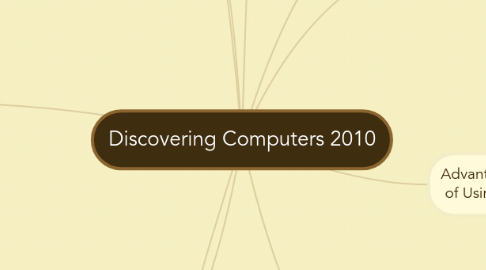
1. Computer Software
1.1. Software
1.1.1. program
1.1.1.1. tells the computer what tasks to perform and how to perform them
1.2. Installing
1.2.1. is the process of setting up software to work with the computer, printer, and other hardware
1.3. Objectives
1.4. Reasoning
1.5. Content
1.6. Method of Instruction
1.7. Method of Evaluation
2. Networks and the Internet
2.1. Network
2.1.1. collection of computers and devices connected together, often wirelessly, via communications devices and transmission media
2.2. Internet
2.2.1. a worldwide collection of networks that connects millions of businesses, government agencies, educational institutions, and individuals
2.3. People use the Internet for a variety of reasons
2.3.1. Communicate
2.3.2. Research and Access Information
2.3.3. Shop
2.3.4. Bank and Invest
2.3.5. Download Music
2.3.6. Share Videos
2.3.7. Web Application
2.3.8. Online Trading
2.3.9. Entertainment
2.4. social networking Web site
2.4.1. encourages members to share their interests, ideas, stories, photos, music, and videos with other registered users
3. Categories of Computers
3.1. Personal Computers
3.2. Mobile Computers and Mobile Devices
3.3. Game Consoles
3.4. Servers
3.5. Mainframes
3.6. Supercomputers
3.7. Embedded Computers
4. Computer Applications in Society
4.1. Education
4.2. Finance
4.3. Government
4.4. Health Care
4.5. Science
4.6. Publishing
4.7. Travel
4.8. Manufacturing
5. Summary
5.1. Basic computer concepts
5.2. Components of a computer
5.3. Networks, the Internet, and computer software
5.4. Many different categories of computers, computer users, and computer applications in society
6. Objectives Overview
6.1. Explain why computer literacy is vital to success in today’s world
6.2. Define the term, computer, and describe the relationship between data and information
6.3. Describe the five components of a computer
6.4. Discuss the advantages and disadvantages that users experience when working with computers
6.5. Define the term, network, and identify benefits of sharing resources on a network
6.6. Discuss the uses of the Internet and World Wide Web
6.7. Distinguish between system software and application software
6.8. Differentiate among types, sizes, and functions of computers in each category
6.9. Describe the role of each element in an information system
6.10. Explain how home users, small office/home office users, mobile users, power users, and enterprise users each interact with computers
6.11. Discuss how society uses computers in education, finance, government, health care, science, publishing, travel, and manufacturing
7. What Is a Computer?
7.1. A computer is an electronic device, operating under the control of instructions stored in its own memory
7.1.1. New node
8. The Components of a Computer
8.1. A computer contains many electric, electronic, and mechanical components known as hardware
8.1.1. Input Device
8.1.2. Output Device
8.1.3. System Unit
8.1.4. Storage Device
8.1.5. Communications Device
9. Advantages and Disadvantages of Using Computers
9.1. Advantages of Using Computers
9.1.1. Speed
9.1.2. Reliability
9.1.3. Consistency
9.1.4. Storage
9.1.5. Storage
9.1.6. Communications
9.2. Disadvantages of Using Computers
9.2.1. Health Risks
9.2.2. Violation of Privacy
9.2.3. Public Safety
9.2.4. Impact on Labor Force
9.2.5. Impact on Environment
9.3. Green computing
9.3.1. involves reducing the electricity consumed and environmental waste generated when using a computer
9.4. Strategies
9.4.1. Recycling
9.4.2. Regulating manufacturing processes
9.4.3. Extending the life of computers
9.4.4. Immediately donating or properly disposing of replaced computers
